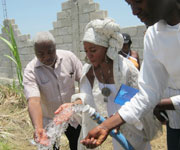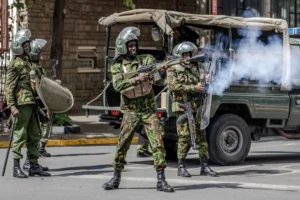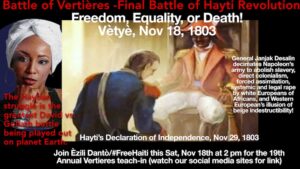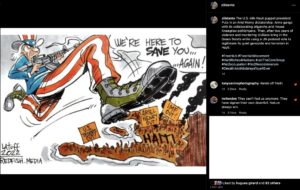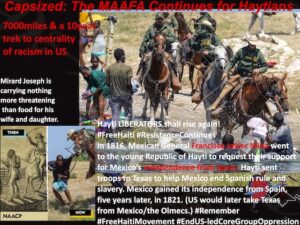Congratulations Joseph Makhandal Champagne, Jr – Mayor, South Toms River
Re:January 1, 2011 – Historic Inauguration of HLLN’s Joseph Makhandal Champagne, Jr. as Mayor of the Borough of South Toms River
Attorney Joseph Makhandal Champagne, a member of the Haitian Lawyers Leadership Network executive board, becomes the first elected Haitian-American Mayor in New Jersey’s History and the first elected Black-American Mayor in the history of the whole Ocean County composing nearly 30 towns.
Congrats Makhandal!!! Bravo brother! Makandal Lives!!!!
Makandal, the Haitian historical figure whose name and irreducible spiritual essence is lifted by HLLN’s Joseph Makhandal Champagne, was so revered by the enslaved Africans in Haiti, it is reported they approached him on bended knees. We re-MEMBER Makandal’s courage, vision, prophecy and legacy today, as we attend the inauguration of one of our own.
Chapo ba, Joseph Makhandal Champagne. The people of South Toms River have indeed chosen a worthy mayor. Thank you Mayor Joseph Makhandal Champagne for extending a worthy Haiti consciousness and for keeping Makandal’s name and legacy alive.
Kenbe la, pa lage. Ale leve Makandal pli wo frè nou.
From all of us at the Ezili Dantò/HLLN Network
Jan 1, 2011
*******
Ezili Dantò Note: Who was Makandal in Haiti history?
2011 – Legba’s at the crossroads…
Makandal was an enslaved African from the Congo kidnapped to Haiti who escaped and led the pivotal guerilla warfare against the European tribes forty years before the August 14, 1791 Bwa Kayiman gathering that began the Haiti revolution. Makandal had special knowledge of herbal cures, was a griot and could read, write and speak Arabic fluently, not to mention French. Makandal brilliantly organized both the maroons and the enslaved Africans to liberate Haiti. In 1751, he led the attack and prophecied that slavery and colonialism would end and all black worldwide would become free. Haiti became free on Jan. 1, 1804.
But the European tribes and their derivatives, would return with various forms of domination, including ecclesiastic colonialism, the Independence Debt, gunboat diplomacy, the Monroe doctrine, Manifest Destiny, occupation, dictatorship and, after the Cold War, “preserving” democracy and stability, NGO false benevolence, disaster capitalism and free trade.
Haiti’s revolution continues, 207 year later.
On the occasion of another Independence Day under occupation, we remember the Ginen Ancestors and the legacy Haiti reaches for. We re-MEMBER Makandal’s role in ushering in the end of chattel enslavement, direct European colonialism and the Tri-Angular trade in Haiti. ( For more details, go to – Francois Makandal: The True Story, Facts, Myths and Legends, and The Black Messiah, and Black Millennium, all, by Antropologist, Mark Davis. )
In 2011, Makandal’s people in Haiti, struggle to end the UN/US occupation, their neocolonialism fraudulent electoral democracy and NGO/free trade impoverishing business in Haiti.
Our Haiti Ancestor, Makandal “…developed an intricate strategy for organizing (en)slaved and “Maroons” to overthrow the whites. He was the first to accomplish an incredible unification of the separate tribes who were previously loath to associate or unite. He also recruited a massive army made up of possibly tens of thousands of slaves on the plantations. He did all this despite not possessing the money necessary for military hardware. While he was able to unite all of the secret societies and hidden maroon camps, itself an unprecedented achievement, he could not persuade the “free blacks,” with their money, to join his revolution.”
“One way or another, Macandal was captured and chained to a stake to be burned alive on January 20, 1758. The fire was lit and Macandal was consumed in flames, but somehow he once again broke his bonds (Korngold, p45). Korngold states that after he broke free he collapsed in the flames. Some slaves claimed he disappeared and became a mosquito or other flying creature as he had promised he would. Other accounts say the French recaptured him and threw him back into the fire, but slaves reported that he fled and was never seen again by anyone who exposed his whereabouts. He had told his followers that he was immortal and would be reincarnated as a deadly mosquito to come back and do more damage than ever before (Heinl, p27). It is interesting to note here that a massive plague of mosquitos carrying yellow fever arrived in swarms during the revolution around 1794 to bring death to over 30,000 British and French troops trying to take Haiti back from the revolutionaries. It was one of the major reasons for the success of the blacks.
French historians characterized his escapes as lucky and based on lackadaisical preparation. For example the post he was fastened to before being set on fire was reportedly rotted, so that it collapsed easily, and that his bonds were flammable. These excuses are suspect. Since the French regularly tortured and burned slaves alive, we are supposed to believe his captors were so incompetent they had not learned how to employ escape-proof or fire-resistant materials. We are to believe Macandal, who had escaped capture over and over and caused so much destruction, was carelessly bound with ropes instead of metal shackles. The French reportedly gathered thousands of slaves from all over the colony to witness his execution, yet they could not manage to set a proper post and fastenings.
33 years after Macandal disappeared, the final uprising began with a speech made by a voodoo priest and former harsh slave overseer, Boukman Dutty. There is little doubt that maroonage played a big part in that event. Michel S. Laguerre, Ph.D, and Professor at U.C. Berkeley, said he believed it was Macandal’s massive Maroon organization, greatly expanded, that Boukman led in 1791 to begin the final revolution which ultimately brought the historic victory. Boukman was no doubt guided by, or paying homage to, Macandal, when he gave a rousing speech to representatives of all the Maroon colonies at the same location (Bois Caiman), where Macandal used to speak to unite them. Bois Caiman, the dense forest located on the Lenormand plantation where Macandal was a slave, is far from Acul where Boukman was from, so it stands to reason that Boukman was directly linked to Macandal or rallying slaves around the memory of Macandal. ” (Excerpted from – Francois Macandal: The True Story, Facts, Myths and Legends. )
-“Even the black Marxist writer C.L.R. James attributed the “Haitian Revolution” to spontaneous rioting by 500,000 black slaves.
Historians have reduced the Haitian Revolution, the only successful overthrow of a colonial power by black slaves, to a ”collective rage,” inspired by the “French Revolution.” Macandal’s story shatters this myth. The Haitian Revolution was the result of the “Macandal Revolution;” which started over 40 years before 1791. ” —Mark Davis, M.A., Anthropologist (Macandal, the Incredible Story)
Add a comment:
Powered by Facebook Comments

